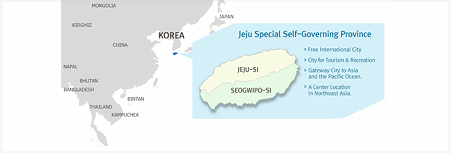Jeju, Korea
World Natural Heritage ‘Jeju-Island’


Located southwest of the Korean Peninsula, Jeju Island is a popular tourist destination among domestic and international travelers alike for its beautiful and pristine natural scenery. The island is home to several UNESCO-designated World Natural Heritage sites such as Manjanggul Cave and Seongsan Ilchulbong Peak, as well as distinct tourist attractions like the numerous oreums (Jeju dialect for small volcanic cones) scattered around the island. Apart from its stunning natural environment, Jeju is also known for dishes made with fresh and savory local products and seafood, offering both visual and palatable pleasure for visitors to the island.



Samda: Three Abundance (Rocks, Wind, Women)
“Three abundances” is a famous term that characterizes the three things that are abundant in Jeju. They are Seokda (rocks), Pungda (wind), and Yeoda (women). That’s why they call Jeju Samdado: the island of three abundance. Seokda originated from the Mt. Halla volcanic activity of the past. People had to cultivate the land through a long process of clearing away the numerous rocks covering the land and then form the inlets for irrigation, and then construct the walls for protection against wind. Seokda, tells of the harsh surroundings of Jeju. Jeju is in the path of typhoons, so the islanders had to fight against the sea. The effect of Pungda and Seokda shows in Jeju lifestyles. Two examples are the thatched roofs of Jeju which are tied up with straw rope, and the fields surrounded by stone walls. Yeoda originated from the fact that most men of Jeju were lost at sea, which made women larger in number. Also, women had to come out to the fields with men due to the Jeju’s living environment being harsh. Yeoda is a comment on population statistics, but moreover, it is a metaphor for the diligent women of Jeju. The famous women divers who fight against wild waves to catch fish are the very symbol of Jeju.
Sammu: Three Non – Existence (Thief, Gate, Beggar)
Sammu is the term meaning there are no thieves, gates or beggars on Jeju. From the old days, Islanders have made “diligence, thrift, interdependence” their virtues to pioneer the rough and harsh surroundings. So, they didn’t steal or beg, which led to the condition of having no use for fences or gates. Also, all the inhabitants were the descendants of Tamna, scholars who were banished due to their great will to keep their principles. Therefore, they all valued their honor highly. They also knew everything about each other, which prohibited them from doing anything bad or dishonorable. So, islanders led diligent, thrifty, and interdependent lives. They didn’t need barriers. They only needed to leave a long log at the entrance of their homes to let the others know that the owner was out.
‘Dolharubang’ means ‘Stone Grandfather’
A Dolharubang is a statue sculpted out of volcanic rock from Jeju that looks somewhat like a man or spirit guardian. Dolharubangs are found all over the island and come in all sizes, from ones that can be placed on one’s desk to those larger than a human. Superstition says that touching its nose helps women give birth to a boy. So, many honeymooning couples can be seen lining up to do just so, each standing to either side to have their pictures taken with their hands on their noses.
Beautiful Jeju, UNESCO Triple Crown
Jeju Island was designated a National Biosphere conservation area in 2002, a World Natural Heritage site in 2007, and received Global Geopark Network certification in 2010. It is the only area in the world that has achieved these three accolades at the same time. In addition, Jeju benefits from a wide range of ecological and geological features. This includes islands, volcanoes, waterfalls, beaches, national parks, caves, and forests.
Where in Jeju Island have you been to?
Let’s choose among the many beautiful travel spots in accordance with your taste. Including the 368 small and large oreum (mountains), and Hallasan Mountain and the blue sea, which is everywhere one looks. Jeju Island’s precious travel spots are waiting for you to visit.
Jeju Island at a Glance




